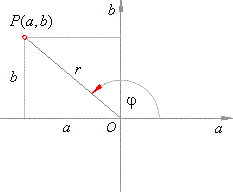|
| Trigonometry |
|
|
Trigonometric
Equations |
 Equations of the Type
a
· cos
x +
b
· sin
x = c
Equations of the Type
a
· cos
x +
b
· sin
x = c |
|
Introducing an auxiliary angle
method |
|
Introducing an auxiliary angle
method example |
|
Trigonometric equations
examples |
|
|
|
|
|
|
| Equations of the type
a
cos
x +
b
sin
x = c |
| To
solve the trigonometric equations which are linear in sin
x and cos
x, and where, a,
b,
and c
are real |
| numbers
we can use the two methods, |
| a)
introducing an auxiliary angle, and b)
introducing new unknown. |
|
| a)
Introducing an auxiliary angle method |
| Consider the constants
a
and b
as rectangular coordinates of a point expressed by polar coordinates (r,
j), |
| then,
a =
r cos j
and b =
r sin j, |
|
|
| By substituting for
a
and b
in the given equation |
| a
· cos
x + b · sin
x = c |
|
obtained is, r
cos
x · cos j
+ r sin
x · sin j
= c or |

|
|
 |
|
| using
addition formula yields,
|
 |
since
|
 |
|
| obtained is
|
 |
the basic trigonometric equation whose solution is known. |
|
| Note that the given equation,
a
cos x + b sin x = c
will have a solution if |

|
| it follows that the constants,
a,
b
and c
should satisfy relation c2
<
a2 + b2. |
|
| Introducing an auxiliary angle
method example |
|
Example: Solve the equation,
sin x +
Ö3
· cos x = 1.
|
|
Solution: Comparing corresponding parameters of the given equation with
a
cos x + b sin x = c
it follows,
|
| a
= Ö3,
b =
1 and c
= 1. |
 |
| By substituting given quantities to the basic equation |
 |
|
 |
| or
x -
30° = +
60° + k · 360° thus,
solutions are, x = 90° + k · 360° and
x′ = -
30° + k · 360°, kÎ Z. |
|
The same solution can be obtained using following
procedure, from sin x +
Ö3
· cos x = 1 |
|
and a
cos x + b sin x = c | ¸ b |
 |
|
that means that we can introduce an auxiliary angle
j
that is |
 |
| sin x
· sin 30° + cos x · cos 30° = sin 30°,
cos (x
-
30°) = 1/2 |
| and this is the same basic equation obtained above. |
|
|
|
|
|
|
|
|
|
|
|
|
|
|
|
|
|
|
|
|
| Pre-calculus contents
G |
|
|
 |
|
| Copyright
© 2004 - 2020, Nabla Ltd. All rights reserved. |